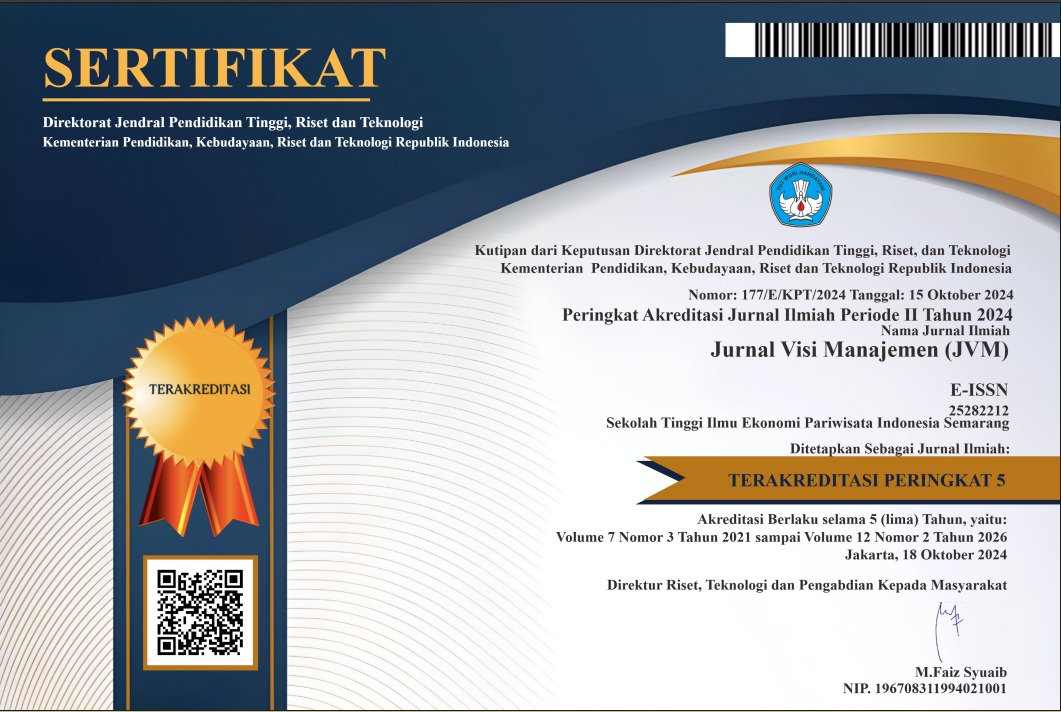Pengaruh Literasi Keuangan Terhadap Niat Menggunakan Shopee Paylater dengan Persepsi Risiko dan Kepercayaan Sebagai Variabe Mediasi pada Generasi Z di Kota Denpasar
DOI:
https://doi.org/10.56910/jvm.v11i2.659Keywords:
Financial literacy, Generation Z, Risk perception, Shopee PayLater, TrustAbstract
This study analyzes the influence of financial literacy on the intention to use Shopee PayLater, with risk perception and trust as mediating variables among Generation Z in Denpasar City. Using a quantitative method with a Structural Equation Modeling-Partial Least Squares (SEM-PLS) approach, data were collected from 200 respondents through purposive sampling. The results indicate that financial literacy has a positive effect on the intention to use Shopee PayLater, while risk perception has a negative effect. Trust in the platform plays a crucial role in increasing usage intention. Additionally, risk perception and trust are proven to mediate the relationship between financial literacy and the intention to use Shopee PayLater. These findings highlight that improving financial literacy, strengthening trust, and reducing risk perception can encourage the adoption of digital payment services among Generation Z.
References
Atkinson, A., & Messy, F. A. (2012). Measuring financial literacy: Results of the OECD/International Network on Financial Education (INFE) pilot study. OECD.
Databoks Katadata. (2023). 8 layanan PayLater terpopuler di Indonesia: Shopee PayLater juara. Retrieved from https://databoks.katadata.co.id
Databoks Katadata. (2023). Milenial dan Gen Z mendominasi pengguna PayLater di Indonesia. Retrieved from https://databoks.katadata.co.id
Gefen, D., Karahanna, E., & Straub, D. W. (2003). Trust and TAM in online shopping: An integrated model. MIS Quarterly, 27(1), 51–90.
Hair, J. F., Hult, G. T. M., Ringle, C. M., & Sarstedt, M. (2019). A primer on partial least squares structural equation modeling (PLS-SEM). Sage Publications.
Hidayat, A., & Susanto, T. (2021). The role of risk perception and trust in mediating the relationship between financial literacy and digital payment adoption. Journal of Financial Technology, 3(2), 45–60.
Lusardi, A., & Mitchell, O. S. (2014). The economic importance of financial literacy: Theory and evidence. Journal of Economic Literature, 52(1), 5–44.
Media Indonesia. (2023). Pengguna PayLater Indonesia alami peningkatan pada berbagai kelompok usia. Retrieved from https://mediaindonesia.com
Perkins, R., & Zuo, J. (2021). Risk perception and the adoption of digital credit services: A study on young adults. International Journal of Consumer Studies, 29(4), 98–112.
Riana, M. A., & Purnomo, I. G. N. R. D. (2023). Pengaruh literasi keuangan terhadap pengambilan keputusan investasi pada Generasi Z. Jurnal Undhira Bali. Retrieved from https://jurnal.undhirabali.ac.id
Slovic, P. (1987). Perception of risk. Science, 236(4799), 280–285.
Tuan, L. (2022). Trust as a mediator in the relationship between financial literacy and usage of digital payment services among Generation Z. Journal of Digital Finance, 15(3), 211–225.
Zhou, L., Li, X., & Zhang, S. (2020). Financial literacy and its impact on the adoption of digital financial services. Journal of Economic Psychology, 65, 133–145.
Downloads
Published
How to Cite
Issue
Section
License
Copyright (c) 2025 Jurnal Visi Manajemen

This work is licensed under a Creative Commons Attribution-ShareAlike 4.0 International License.







